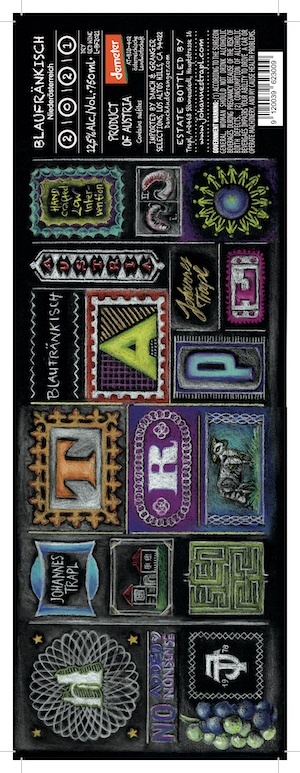

Trapl, Carnuntum, Austria
“Working organically was the right decision. Vines that thrive in a richer environment also produce more diverse, more complex wines.” — Johannes Trapl

At a Glance
2003
https://www.trapl.com
Carnuntum
Cool Continental
Heavy loam and loess, sandy gravelly, schist
170m-300m
The Leitha Mountains, the Arbesthaler Hills near Göttlesbrunn and the Hainburger Mountain
Zweigelt, Blaufränkisch, Sankt Laurent, Pinot Blanc, Grüner Veltliner, Welschriesling
18 hectares
Biodynamic (Demeter Certified)
Biodynamic
https://www.trapl.com
Carnuntum
Cool Continental
Heavy loam and loess, sandy gravelly, schist
170m-300m
The Leitha Mountains, the Arbesthaler Hills near Göttlesbrunn and the Hainburger Mountain
Zweigelt, Blaufränkisch, Sankt Laurent, Pinot Blanc, Grüner Veltliner, Welschriesling
18 hectares
Biodynamic (Demeter Certified)
Biodynamic

Johannes Trapl
The People
Johannes Trapl founded his winery in 2003 when he was just 25 years old. It was Johannes' grandfather that planted most of the family estate’s vineyards in Carnuntum, a region known at the time for big, inexpensive Zweigelt wines. After working for Cardinale winery in California, Johannes took over the responsibility of managing the small family winery with initially only half a hectare (1 acre) of vineyards and also worked for the nearby Muhr-van der Niepoort estate. Today, together with Dorli Muhr of Muhr-van der Niepoort, Johannes Trapl is co-instigator of the renaissance of Spitzerberg, a small extension of the Little Carpathians made of limestone and schist, which can produce wines with extraordinary elegance and minerality.

The Appellation
The wine-growing region Carnuntum stretches from the eastern limits of Vienna to the border of Slovakia. The vineyards are dispersed in three hilly landscapes: the Leitha Mountains, the Arbesthaler Hills near Göttlesbrunn and the Hainburger Mountain. Heavy loam and loess soils and sandy gravelly soils dominate the slopes of the Arbesthaler Hills in Stixneusiedl. The hot summers and cold winters that characterize the Pannonian climate, the proximity of the moderating effects of the Danube River and Lake Neusiedl allow red grapes to ripen perfectly.

Johannes and Melanie Trapl
Vineyards
The vineyards have been certified organic since 2006 and the entire winery since 2010. Meanwhile, the focus is now on applying biodynamic principles in the vineyard and avoiding using mineral fertilizers. Conscientious canopy management and working with green cover allows grapes to ripen more gradually and develop more aromatic intensity. The biggest challenge is choosing the perfect time to pick grapes, which should be based on the taste of the grape, not its sugar concentration. Harvest starts rather early with the first selection of grapes, thus reducing vigor and shoot growth. In the second round, grapes don’t have that much “puppy fat” and exhibit rather cool aromas as Johannes' preferred style is freshness and liveliness.

Winemaking
The cellar's most striking feature is the big vats in which grapes for the premium wines are foot-trodden. This method, used for 20 tons of grapes each year, is physically exhausting but the resulting quality of the wines recompense all efforts. Fermentation occurs naturally without the addition of cultivated yeasts or enzymes. There is minimum intervention with the premium wines in the cellar to simply let them be. The wines are then given enough time to mature, in stainless steel tanks, oak casks or amphoras, before they are brought to market, which allow them to show their true potential and pedigree.




White Wine , Organic
Grüner Veltliner;
10.5%
1.1 g/l
4.9 g/l
Grüner Veltliner;
10.5%
1.1 g/l
4.9 g/l
The 10.5% alcohol doesn’t reference residual sugar or reflect being picked way too early. Somehow this wine pulls off extended maceration, relatively short aging, and is remarkably alive. It goes through many stages after opening and none of them require drinking fast and cold. Literally “Carpathian schist,” this is 100% Grüner Veltliner from the Spitzerberg planted in 1970. Grapes were hand harvested, destemmed, and then gently macerated between 60-90 days in a 430 liter Georgian qvevri (above ground). Following maceration and fermentation, the wine was aged in both used Oak and Qvevri for 6 months. Bottled unfined and unfiltered with total SO2 under 10ppm, this can be decanted with confidence and really enjoyed.

Red Wine , Organic
St. Laurent;
9.7%
1.7 g/l
5.2 g/l
St. Laurent;
9.7%
1.7 g/l
5.2 g/l
This is the wine that originally brought us to Trapl in the first place. Planted in 2000 near the village of Sarasdorf about a 5 min drive south of the winery, the soil here is heavy with gravel, loam and loess. Grapes are hand picked and then destemmed and foot trodden. After 6-8 days of maceration, they are gently pressed into 500 liter oak barrels for 14 months of aging. Bottled unfined and unfiltered with less than 10ppm of total SO2, this is an extremely difficult grape to farm. To then make it super ethereal and delicate at 10.5% alcohol without the aid of carbonic or extended maceration, this is risk on risk behavior that pays off. Sankt Laurent is often referred to as the savage sibling of Pinot Noir, it’s more like the Victor of Aveyron of Pinot Noir – noble DNA but raised feral and wild.

Rose Wine , Organic
Zweigelt; St. Laurent; Blaufränkisch;
10.8%
1.5 g/l
6.5 g/l
Zweigelt; St. Laurent; Blaufränkisch;
10.8%
1.5 g/l
6.5 g/l
This is something we had while BBQ’ing at the winery that we’re finally able to bring in. Chillable and Rosé’ish, it’s a 100% whole cluster, 1-2 days maceration, fermented in stainless steel, and aged in both barrel and Qvevri for 8 months. The stem inclusion gives plenty of bitterness and aromatics, and the fruit is plenty tart to balance out. Zero additions of any kind, it’s a remarkable “Rosé” from Johannes’s Stixneusiedl vineyard.